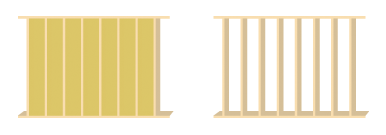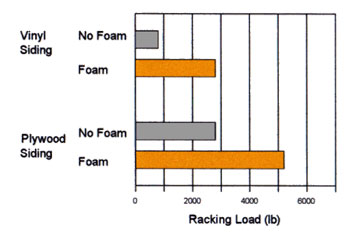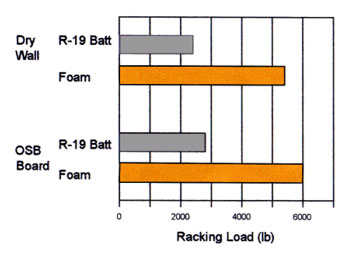The walls in your home are the main structural component of the building. In wood frame construction, the weight of the roof, shingles, standing rain water and any snow add weight and exert downward forces on the walls resulting in a compressive force.
Strong winds and gusts from storms also impose lateral forces onto your home’s walls. These forces can distort the walls with what is called a "shearing force."
Building codes require that your home’s walls be designed to withstand these various forces and loads. However, when walls are built to just the minimum standards, while still safe, symptoms of movement such as creaking and shaking during high winds or occupant usage often occurs.
Higher density, closed cell spray foam insulation inside your stud walls fully adheres to both the exterior sheathing and the studs, reinforcing both. With this added rigidity, there will be less wall movement due to wind, vibration, and occupant activity. Additionally your walls have greater than code required resistance to "racking events" such as hurricanes or other strong wind situations.
SPF also can add structural strength to buildings. NAHB Research demonstrated SPF filled walls could add from 75% to 200% racking strength to walls of OSB, plywood, light gauge metal, vinyl siding or gypsum board.

Racking Test
Shearing forces on a wall tend to distort the wall from its original shape as a rectangle into a parallelogram. To test a wall’s resistance to the shear forces imposed by wind loading, engineers use a "racking test." An 8 ft. x 8 ft. model wall is built and placed in a large frame. The base of the wall is secured to the frame and a horizontal (lateral) force is applied at one upper corner. The force is increased in 400 lb. increments until the wall structure fails.
Spray Foam’s affect on wall strength
In a series of racking tests1, walls with and without spray-applied polyurethane foam insulation were compared. Two exterior facing materials were tested:
- Vinyl siding over 15-lb. building paper; and
- Textured plywood siding.
All wall panels were faced with ½-inch sheetrock on the interior side and used 16 inch stud spacing. For the stud wall panels that were insulated with spray-applied polyurethane foam, the stud cavities were essentially completely filled with foam of 1.5 lb/ft³ density.
As the graph indicates, stud walls filled with spray-applied polyurethane foam add significant strength to home walls. Furthermore, for each load applied, the foam filled walls deformed less and offered greater resilience.

In a second series of racking tests2, spray-applied polyurethane foam insulation was compared with conventional R-19 glass fiber batts. In one comparison, the wall panels were faced both sides with dry wall. In the other comparison, the wall panels were faced one side with OSB (oriented strand board) with dry wall on the opposite side. In both cases, the wall panels used steel studs spaced 24 inches on center and the average foam density was 2.26 lb/ft3.
Once again, the graph indicates the greater strength of the spray foam insulated wall system.
In a second series of racking tests2, spray-applied polyurethane foam insulation was compared with conventional R-19 glass fiber batts. In one comparison, the wall panels were faced both sides with dry wall. In the other comparison, the wall panels were faced one side with OSB (oriented strand board) with dry wall on the opposite side. In both cases, the wall panels used steel studs spaced 24 inches on center and the average foam density was 2.26 lb/ft3.
Once again, the graph indicates the greater strength of the spray foam insulated wall system.

- Test results are reported in "Testing and Adoption of Spray Polyurethane Foam for Wood Frame Building Construction" (May 25, 1992) prepared by NAHB Research Center for The Society of the Plastics Industry/Polyurethane Foam Contractors Division.
- Test results are reported in a letter from Bob Dewey, Mechanical Engineer, NAHB Research Center to Mason Knowles, The Society of the Plastics Industry/Spray Polyurethane Foam Division (November 18, 1996).